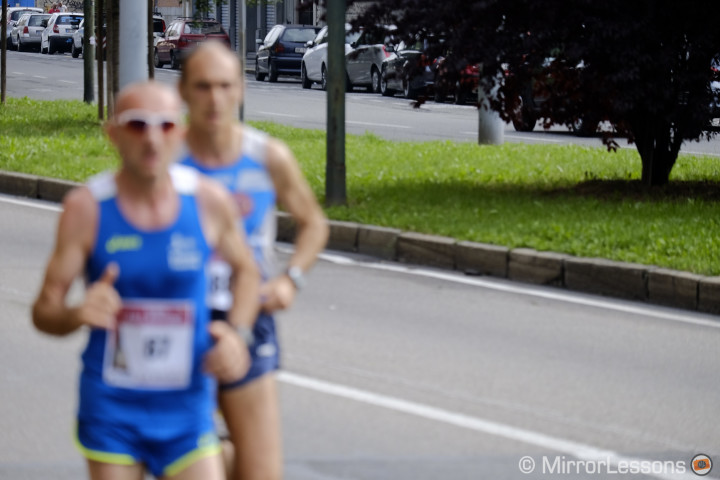Note: in June 2015, Fujifilm released the firmware version 4.00 that adds several new features concerning the autofocus. You can read my in-depth review about it here.
In my opinion, there are two ways to evaluate the autofocus of a camera. The first is to leave everything to the camera. You point and shoot and see how the camera software/hardware behaves. The second way is to understand how the camera works to get the most out of it. This requires not only more patience and time, but also the presence of various, and sometimes difficult, conditions to truly understand what the camera’s limits are.
A couple of weeks ago, The Camera Store released an interesting comparison video between the four MILC cameras that claim to have the fastest AF in the world. The Fujifilm X-T1 proved to be the least efficient of the four. Is it bad? That all depends on how you choose to interprete these results. In that particular video, for example, the fact that the OM-D E-M1 was the best of the four for continuous AF tracking and buffer capabilities was, in my opinion, a far more interesting result than the final ranking itself.
So back to the X-T1: if it ended up in last position, does that mean it can’t do the job?

Note: this article contains GIF animations.
First thing: check for firmware updates
If you decide to shoot with Fujifilm cameras, firmware updates are very important because they do bring essential improvements. I decided to test the X-T1 for action last weekend when there were lots of sports events in town including a marathon and bike races. I managed to borrow an XF 55-200mm f/3.5-4.8 lens which is currently the fastest telephoto zoom available for the X system.
I immediately started the test with the camera by going to The Bike Republic where I shot a BMX competition. When reviewing the pictures later on in the evening, the results were a little bit disappointing as many shots were out of focus.

I then checked to see if there was a firmware update for the lens and it so happened that version 1.11 was available (the lens had version 1.10).
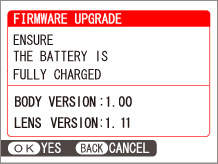
The next day I went back to the same event and, like magic, I got far better and more consistent results with continuous autofocus.

Second thing: understand the camera settings
Shooting sports means combining different settings in order to get the best performance out of the camera. This is even more important with the X-T1 because the camera doesn’t offer true tracking capabilities. When I say this, I mean that the X-T1 doesn’t have an AF-C Tracking mode where the focus point will move automatically within the frame, following the subject according to its contrast or its colours. So if you don’t keep the subject within the focus point that you set, the camera will automatically focus on something else.
The best way to track a subject then is to use a relatively large focus point that can be adjusted with the front dial on the grip when selecting the focus point position.

The larger the point, the more margin the camera has. This proves that knowing the camera is important because for example, with the Olympus OM-D E-M1, it is the opposite: the smaller the focus point is, the more accurate AF will be. Every camera has its own logic.
Another important setting to turn on is the Better Performance option under the Power Management menu. It will decrease battery life but improve AF speed.

The X-T1 has two continuous shooting modes (CH and CL). CH will allow you to shoot at 8fps in AF-C while CL is significantly slower. Also, in CH mode you can only select the focus point position within the 9 phase detection points the sensor possesses in the center. This means that the camera will only focus within the frame center area. In CL, the other contrast detection points are also available but if you choose one of them, the AF is less effective and accurate at tracking.
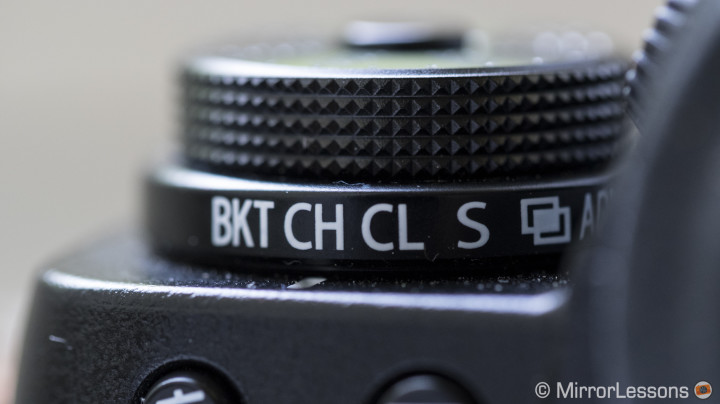
You can either select a single AF point or the Multi mode. With the latter, the camera will choose the best AF area automatically. While I find the results with Multi fine concerning AF accuracy, the camera’s reactiveness isn’t as good. Also, when aiming and pre-focusing by half pressing the shutter button, the camera will first shorten the focus distance, then increase it again to lock onto the subject. That back and forth movement can be too slow when shooting in the middle of an action-packed scene.
So to sum up: AF-C, single large AF point, CH burst mode.
Make sure to select focus priority for the AF-C mode in the menu so that the camera only fires when the focus is locked. I also activated the pre AF option, meaning that the camera focuses even when the shutter is not being pressed. That way I found the AF more reactive.
Finally, buffer (the camera’s ability to keep shooting while storing files on the SD card) is also very important. Its speed will of course depend on which SD card you are using. The X-T1 is the first camera to be compatible with SDXC(UHS-II) type cards which offer more than 200MB/s of writing speed. So for the best performance, that’s what you need.
However, if you have slower memory cards like me (Sandisk Extreme – 80MB/s), a good option is to shoot JPG only. With that configuration the X-T1 allowed me to shoot continuously for enough time, while with the RAW+JPG configuration it would stop after the first 9-10 shots. Shooting JPG only isn’t a problem for me because in this case I ended up with thousands of photographs and having a RAW version for each of them would definitely mean switching cards often during the day. Also, for every action you shoot, you will end up using only a couple of images in the end. If you are doing it for work, chances are that this image must be sent quickly, so having a JPG ready on-camera is more convenient.
Third thing: understand the action

Shooting sports isn’t easy. You have to know a little bit about the sport and understand what’s going on in the action. If a subject suddenly changes direction and you are not prepared for it, it will be out of your frame in less than one second.
I do not shoot sports for a living, so I haven’t got enough experience to share interesting tips and tricks, also because I believe it depends on which sport you are talking about. Tracking a marathon man is easier because he follows a straight line. Shooting BMX bikers and all the different stunts they do is harder if you don’t know which stunts they perform. So at the beginning I composed a larger frame and zoomed in only when I had developed a sense of the potential moves they would make.

Naturally, the better you are able to track a subject, the more you are “helping” the camera do its job well. And believe me, if you are not used to it, keeping a marathon runner at the center of the frame isn’t that easy and requires a little bit of practice as well.
X-T1 in action, chapter 1: subjects coming toward me
The most “classic” test one can begin with is tracking a subject coming toward the camera. For this test, I had the chance to shoot both the Turin Half Marathon and the Cyclocross race at The Bike Republic event.




I can say very easily that the X-T1 didn’t have any particular problems following a single subject. I got an average of 90-95% of the pictures in focus for every burst shoot, and more than once a 100% positive result, even when the subject got very close to me.

When shooting a group of people, the camera occasionally changed focus between them but I must say that overall it performed well. The X-T1 has a Motion Predictive AF, meaning that the camera will calculate speed, acceleration and deceleration in order to predict the distance of a moving subject. It is not perfect but it works better than I thought (also in Multi AF mode) but as I explained earlier, I prefer to use the single AF point.
The more precise your settings are, the better results you get.

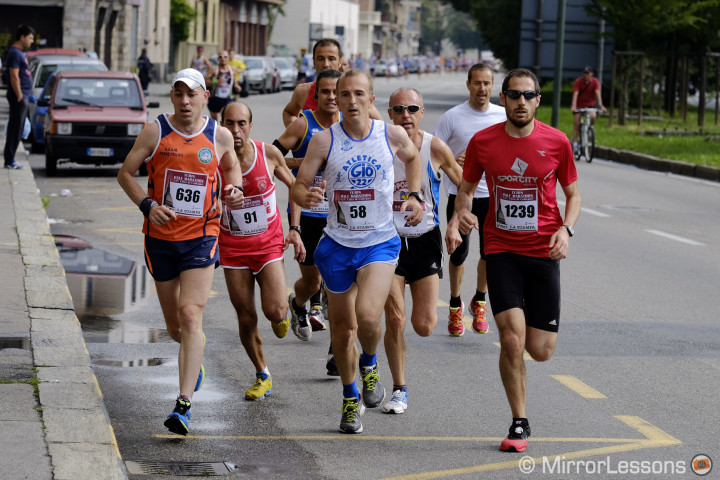
In the example below, the X-T1 switched focus between the two runners three/four times. In this case it wasn’t a problem because the two men were very close together. With more distance between them, the difference in focus distance would have been more pronounced.

Again, the important thing is to keep the subjects within your focus point. If they go outside of it, the camera will only hold on for a very brief moment before it starts changing the focus distance unless you can adjust your frame quickly enough, as you can see in the example below.
With the Cyclocross race, my conclusions are the same: the X-T1 tracks faster subject like a biker very well. Unfortunately I couldn’t test a car race as well but I’m confident that it can reproduce the same results.

The only limit I could see in this type of scenario was when I started to track the subject when it was already at a close distance. The X-T1 proved slow in locking and tracking, allowing me to capture only a couple of pictures that most of the time were out of focus anyway. So the best solution is to start tracking the subject when he/she is still far away (when he or she fills the frame from head to toe).
X-T1 in action, chapter 2: subjects moving perpendicular and in different directions
The Cyclocross race gave me other interesting scenarios to test. For example, in one particular section of the track, the bikers had to constantly change direction in a crowded space (serpentine). Since X-T1 doesn’t have true tracking capabilities, I had to be very precise in keeping the subject in the center and I missed some shots. Moreover, there were also lots of disturbing elements like barriers in the fore and background, coloured tape and other elements. The X-T1 confused the subject with the background several times like in the example below.




A busy background confused the X-T1 in other situations as well. For example at the marathon, I noticed the same issue a couple of times when I was panning to follow a runner.
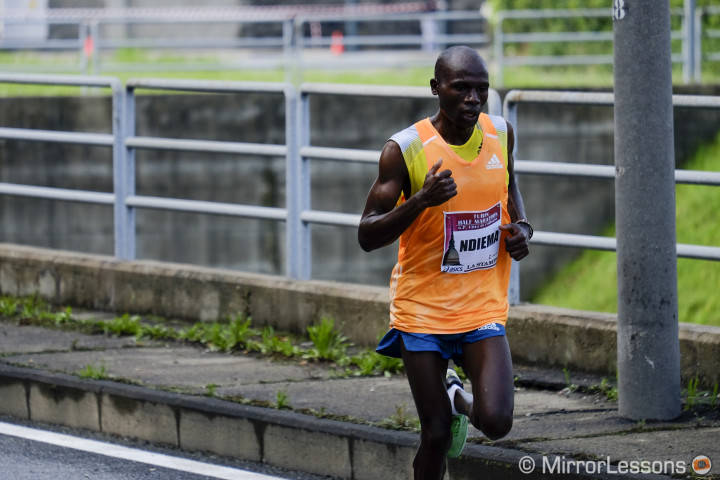

Another example is with the BMX competition, which was in a tight space. For example I found that many of the shots taken with the brick wall in the background actually had the wall in focus and not the biker. In most of the shots the difference is barely noticeable because of the f/4.8 aperture and the short distance between the subject and the wall. I wonder what would happen with a f/2.8 constant aperture zoom.

I also tried some shots with the XF 10-24mm f/4 and I got very good results especially when panning. Given the very closed aperture, it is hard to get something out of focus anyway (not counting the blurry effect due to the slow shutter speed of course).
What is really great with the X-T1 is the 8fps in AF-C.
It is very fast and allows you to easily capture every step of the action without missing anything. After the first day, I tended to start shooting with some delay to capture the essence of the action only, so that I ended up with fewer photos per scene.
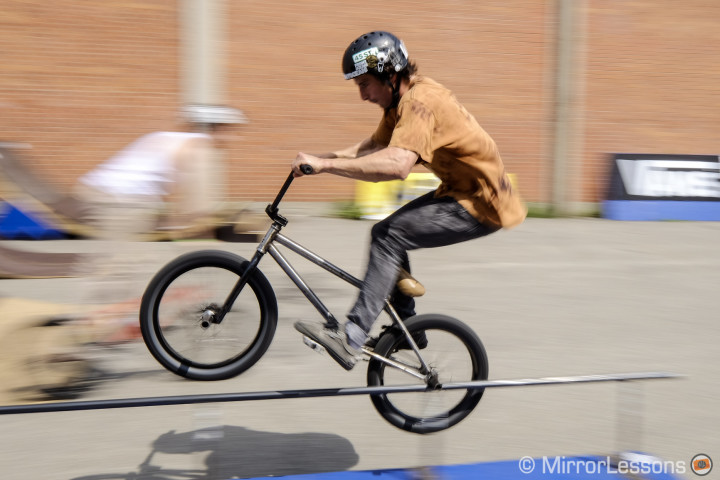


Another great test was indoors at a Bike Polo match. It was very interesting because there was less light available and it meant following an action that constantly changed direction, the number of subjects, and the number of elements in the front and rear. In that situation the X-T1 surprised me. It really did a good job at keeping the action in focus.

The only limit I encountered was when a subject or an element entered the foreground. The X-T1 changed the focus distance almost immediately, except in some rare situations where the element only appeared for a very brief moment.

X-T1 in action, chapter 3: low-light conditions
A couple of months ago I remember reading a very good article from our Italian friend Giampiero Marchiori who tested the X-T1 in a theatre with the XC 55-230mm f/4.5-6.7mm. I was curious to try the X-T1 in the same type of conditions.
I got the chance to do so later on this week thanks to the Egri-Bianco Dance company that premiered its last show of the year. I was called to shoot the video for the show so I tested the X-T1 during the rehearsal. This means that I cannot share the same number of pictures with you. Instead I will publish only a couple to show you that the X-T1 performed very well even in challenging light conditions or in other difficult situations like the one with the white sheet below.


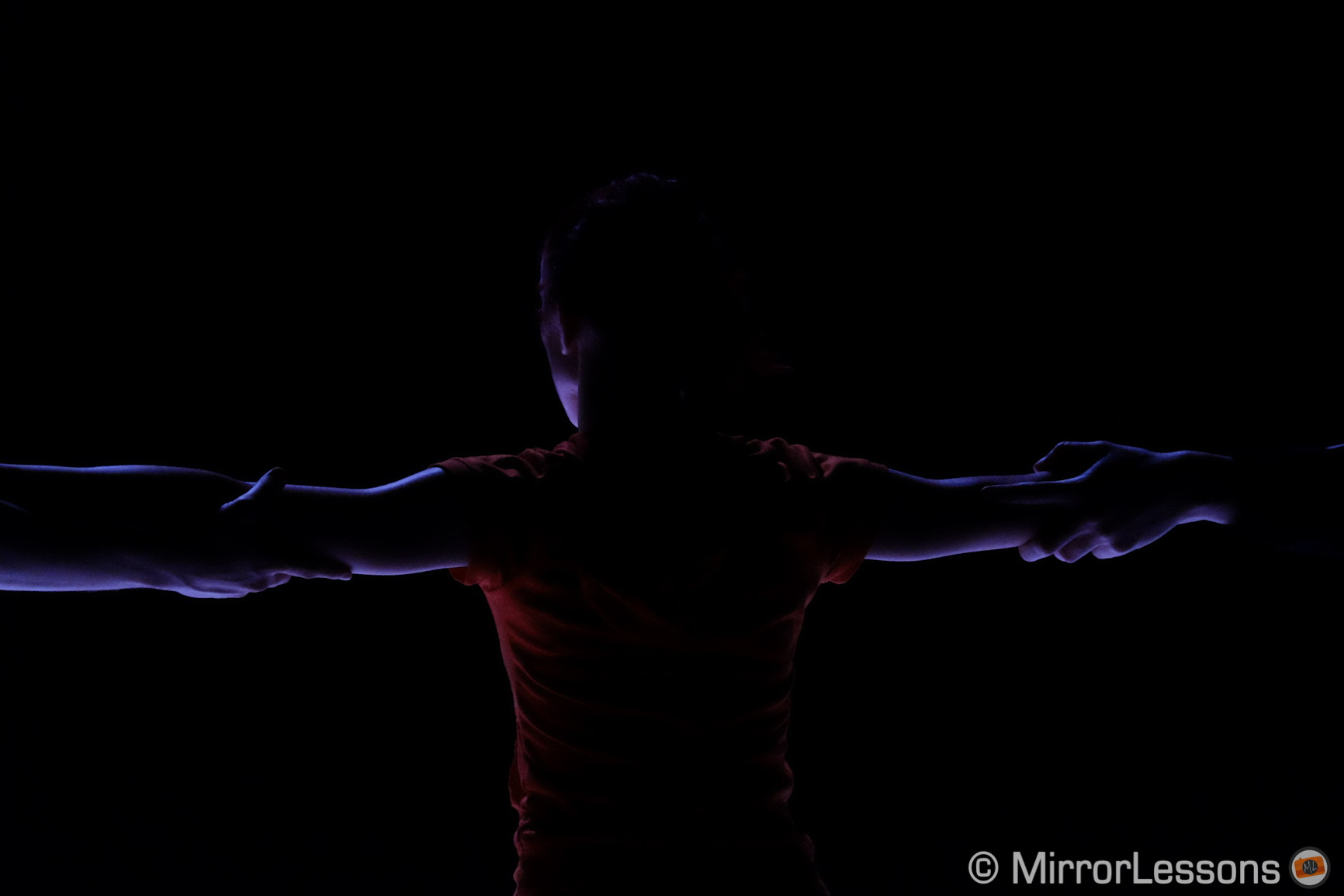
Now in these situations, there are some limits that aren’t strictly camera related.
For this kind of work you need fast lenses. I had to set ISO up to 6400 in order to keep a “safe” shutter speed. But this shows the potential that the X-T1 has. One particular moment surprised me, and this was during the show’s finale where only one dancer was left on the scene. During his rehearsal he wore a dark shirt and was running in circle. I followed him, meaning that the X-T1 was tracking a dark subject against a dark background. The results were mixed but I would have expected far worse. In part, the bad pictures were also related to the 1/100 shutter speed. I can also say that I’ve seen other MILC cameras perform far worse than the X-T1 in this kind of situation.
The only real flaw I noticed in this situation was that the camera started shooting when the picture was still way out of focus and failed to adjust. It was as if the camera was set to shoot priority instead of focus priority. So I guess that in low-light conditions the camera has the tendency to become more confused at certain times.
Lacking a true AF tracking mode is also limiting when for example you want to keep two dancers inside your composition. You have to quickly and manually adjust the focus point on one or the two dancers. It works for slow action but less if they are moving fast.
Face detection: good for tracking?
In a group situations, I wouldn’t use the face detection option as it can change the focus point too often. But for a single subject, it might work.
When I reviewed the XF 56mm f/1.2, I took a series of continuous shots of Heather walking in the rain. The results weren’t 100% perfect but it showed some potential. I honestly don’t remember if I had the Better performance option turned on at the time so that might have affected the results a little bit. I wouldn’t trust it for fast moving subjects but it can be of some help in certain situations.

The Fuji X-T1 autofocus: conclusion
There are of course other interesting kinds of action shots that can be used to test the camera further but I think that these examples are already enough to write an interesting conclusion.
Do the X-T1’s AF capabilities deliver?
My opinion is that, yes, it does, and it does it well. It isn’t the fastest, and there are still some limits and aspects that can be enhanced. If you are a professional photographer who shoots sports for a living, the X-T1 wouldn’t be the first camera I’d recommend. But if you are a sports shooter, you probably don’t need me to tell you that anyway.
Let me add that it isn’t just a question of the camera itself. For the X system we also need faster telephoto lenses. The 50-140mm f/2.8 is coming (end of the year) and that will certainly improve the camera’s capabilities a little bit because history has taught us that every new Fuji lens has a faster AF than the previous lenses.
The only thing the camera really lacks is a more advanced tracking capability. It would be helpful for the composition as you wouldn’t be overly concentrated on keeping the focus point on your subject when tracking. However I am confident that this will come in future camera releases. The improvements regarding AF throughout the years can only lead me to think that in one year or two, with more lenses, the X system will be terrific for sport photography.

You will notice that I didn’t talk about AF-S.
Not that it is less important, but I can simply says that it works. Again, it might not be as fast as an OM-D E-M1 or a Lumix GH4, but it is fast enough for 99% of the situations you’ll find yourself in. It is slightly less effective in low-light conditions as with every other MILC cameras that I’ve tried (including the best ones), and yes, sometimes it is a little but slow to react, but the X-T1 still remains the best Fujifilm camera regarding AF. The differences between it and other MILC models really are minimal.
The X-T1 works if you understand that when it comes to autofocus, the photographer can have a significant impact on its performance.
Let me explain this with a final example: for the BMX race, instead of using AF-C for the stunts, I could have stuck with AF-S, pre-focused on the ramp, locked it and shot when the subject started to “fly in the air”. A simple old technique that will always work regardless of the camera you use.

A big thanks to Chiara for giving me a media pass for the Bike Republic event and Cristian at MCdigital camera store.
Featured articles:
- Fujifilm Raises the Bar! – Hands-On Review of the new Fujifilm X-T1
- The first wedding shot with the Fuji X-T1 – Guest Post by X-Photographer Max De Martino
- Sometimes, it’s just about love – A Fujinon XF 56mm f/1.2 Review
- Three days walking through the Cinque Terre with the Fuji X-T1 & XF 10-24mm f/4


